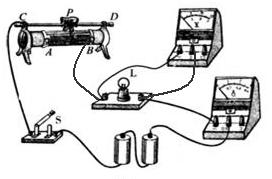在“测小灯泡电功率”的实验中,小灯泡的额定电压是2.5V,滑动变阻器上标有“10Ω 2A”字样,小灯泡的电阻小于10Ω。
请用笔画线代替导线,将图(甲)所示的实物电路连接完整(要求导线不交叉)。

连接好电路后,为了保证电路的安全,要将滑动变阻器的滑片移至 端(填“A”或“B”),才能闭合开关;闭合开关时,发现电流表指针偏向没有刻度的那一边,造成这一故障的原因是 。
排除故障,闭合开关,电压表的示数为1.5V,为了让小灯泡正常发光,应将滑片向 端移动(选填“A”或“B”)。
当小灯泡正常发光时,电流表示数如图(乙)所示,通过小灯泡的电流是 A。小灯泡的额定功率是 W。
将图17(甲)中的小灯泡更换成定值电阻,且电路连接完好,还可以完成的实验是( )
A.探究电流的磁场强弱与电流大小的关系 B.探究电流与电压关系
C.探究电流产生的热量与电阻的关系 D.探究电流与电阻关系
(1)略 (2)A(说明:若滑动变阻器接了B接线柱,则此空填A,反之填B) 电流表的正负接线柱接反了 (3)B(说明:若滑动变阻器接了B接线柱,则此空填B,反之填A) (4)0.3 0.75 (5)B
(1)电压表的量程由灯泡的额定电压来确定,电压表与灯泡并联.
滑动变阻器选择一上一下串联在电路中.
(2)连接好电路后,滑动变阻器的滑片处于最大阻值处,起到保护电路的作用.
电流表的指针反偏,电流表的正负接线柱接反了.
(3)电压表测灯泡电压,使灯泡的电压增大,电路电流增大,总电阻减小,滑动变阻器连入电路的部分减小.
(4)电流表读数:确定使用的量程,确定每一个大格和每一个小格各代表多少.知道灯泡的额定电压和额定电流,根据P=UI计算额定功率.
(5)完成每个实验各需要什么器材,各需要控制什么,需要改变什么,分析本实验器材是否能满足实验要求
解:(1)灯泡的额定电压为2.5V,电压表选择0~3V量程,电压表并联在灯泡两端.
滑动变阻器已经选定了上面接线柱,任意选择下面一个接线柱,把滑动变阻器串联在电路中.如图.

(2)滑动变阻器接入右半段,滑片处于A端,滑动变阻器连入电路的电阻最大,对电路起到保护作用.
电流表的指针反偏,电流表的正负接线柱接反了.
(3)电压表测量灯泡的电压,电压表示数为1.5V,灯泡两端的电压为1.5V,
要使灯泡两端电压由1.5V增大到2.5V,电路电流要增大,总电阻减小,滑动变阻器连入电路的部分减小,滑片向B端移动.
(4)电流表使用的0~0.6A量程,每一个大格代表0.2A,每一个小格代表0.02A,电流为0.3A.
P=UI=2.5V×0.3A=0.75W.
(5)A、电流磁场的强弱无法直接观察,通过观察电磁铁吸引大头针的多少来反映磁性的强弱.本实验器材不能完成.
B、探究电流与电压的关系时,控制电阻不变,通过滑动变阻器改变定值电阻两端的电压,来探究流与电压的关系.本实验器材能完成.
C、Q=I2Rt,探究电流产生的热量与电阻的关系时,控制电流和通电时间不变,只有一个定值电阻,不能改变电阻,无法进行实验.本实验器材能完成.
D、探究电流与电阻的关系时,保证电压一定,改变电阻大小,只有一个定值电阻,不能改变电阻,无法进行实验.本实验器材能完成.
故答案为:(1)如图;(2)A;电流表正负接线柱接反了;(3)B;(4)0.3;0.75;(5)B.
